Blood-thinners with certain medications associated with increased risk of bleeding. Anticoagulants are prescribed to patients with atrial fibrillation.

‘Physicians prescribing non-vitamin K oral anticoagulants (NOACs) medications should consider the potential risks associated with concomitant use of other drugs.’





However, for patients with atrial fibrillation, NOACs are often prescribed with other medications that share metabolic pathways that may increase major bleeding risk.Chang-Fu Kuo, M.D., Ph.D., of Chang Gung Memorial Hospital, Taoyuan, Taiwan, and colleagues used data from the Taiwan National Health Insurance database and included 91,330 patients with nonvalvular atrial fibrillation who received at least one NOAC prescription of dabigatran, rivaroxaban, or apixaban and estimated the bleeding risk associated with or without the concurrent use of 12 commonly prescribed medications that share metabolic pathways with NOACs (atorvastatin; digoxin; verapamil; diltiazem; amiodarone; fluconazole; ketoconazole, itraconazole, voriconazole, or posaconazole; cyclosporine; erythromycin or clarithromycin; dronedarone; rifampin; or phenytoin).
Among the patients in the study, 4,770 major bleeding events occurred. The researchers found that concurrent use of amiodarone, fluconazole, rifampin, and phenytoin with NOACs had a significant increase in incidence rates of major bleeding than NOACs alone.
Compared with NOAC use alone, the incidence rate for major bleeding was significantly lower for concurrent use of atorvastatin, digoxin, and erythromycin or clarithromycin and was not significantly different for concurrent use of verapamil; diltiazem; cyclosporine; ketoconazole, itraconazole, voriconazole, or posaconazole; and dronedarone.
The study notes some limitations, including that bleeding risk and anticoagulant treatment in the Asian population have been recognized to be different from the Western population. Therefore, the external generalizability of these results, particularly to a Western population may be limited.
Advertisement
Source-Eurekalert












